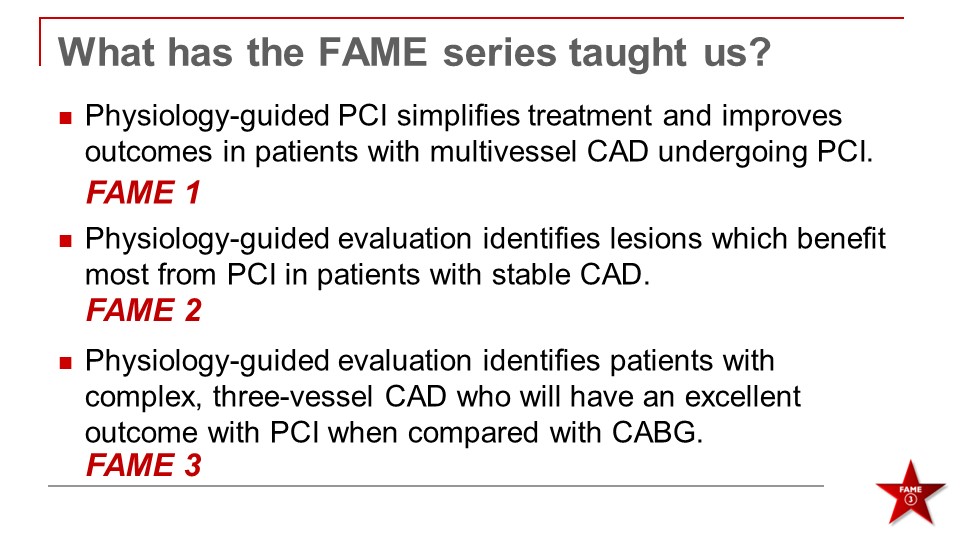News | TCTAP 2024
The Series of FAME Studies: A Paradigm Shift in Our Thinking About Interventional Cardiology
Coronary Imaging & Physiology: Updated Concepts and Issues

William F. Fearon
Stanford University, USA
Coronary artery disease (CAD) management has significantly evolved over the past decade, largely due to the pivotal findings from the Fractional Flow Reserve versus Angiography for Multivessel Evaluation (FAME) trials. The FAME 1, FAME 2, and FAME 3 studies collectively underscored the transformative role of fractional flow reserve (FFR)-guided percutaneous coronary intervention (PCI) in optimizing treatment strategies for patients with CAD.
Published in 2009, the FAME 1 trial, laid the groundwork for using FFR in guiding PCI. Traditionally, angiography has been the cornerstone for identifying significant coronary stenoses. However, the FAME 1 trial demonstrated that incorporating FFR measurements during PCI significantly improved patient outcomes. The study included 1,005 patients with multivessel CAD. It revealed that FFR-guided PCI, compared to angiography alone, resulted in a lower incidence of major adverse cardiac events (MACE) over 1 year (13.2% vs. 18.3%, p=0.02). FAME 1 established that physiology-guided PCI simplifies the treatment process and enhances the prognostic outcomes for patients undergoing multivessel PCI.
The FAME 2 trial, published in 2014, further validated the importance of FFR in patients with stable CAD. De Bruyne and colleagues conducted a study involving 1,220 patients, comparing outcomes between those who received FFR-guided PCI and those managed with medical therapy alone. The results showed patients in the FFR-guided PCI group had a significantly lower rate of the primary composite endpoint of death, myocardial infarction (MI), or urgent revascularization compared to the medical therapy group (4.3% vs. 12.7%, p<0.001). This trial highlighted that physiology-guided evaluation can identify lesions that benefit most from PCI in patients with stable CAD.
The most recent FAME 3 trial explored the efficacy of FFR-guided PCI in patients with complex, three-vessel CAD. Fearon et al. conducted a comparison between FFR-guided PCI and coronary artery bypass grafting (CABG). Encompassing 1,500 patients, the study concluded that FFR-guided PCI is a viable alternative to CABG, with comparable outcomes in terms of the primary composite endpoint of death, MI, stroke, or repeat revascularization at 1 year (10.6% vs. 6.9%, p=0.34). The findings from FAME 3 suggest that physiology-guided evaluation identifies patients with complex, three-vessel CAD who may have an excellent outcome with PCI compared to CABG.
The FAME trials collectively reinforce the critical role of physiology-guided intervention in the management of CAD. Using physiology-based assessments is expected to help clinicians more effectively stratify patients, personalize treatment strategies, and ultimately improve clinical outcomes (Figure 1).

Figure 1. Lessons from the FAME trial series
TCTAP Workshops
Coronary Imaging & Physiology: Updated Concepts and Issues
Thursday, April 25, 2:00 PM ~ 3:34 PM
Presentation Room 1, Level 1
Edited by

Se Hun Kang, MD
CHA Bundang Medical Center, Korea (Republic of)

William F. Fearon
Stanford University, USA
Coronary artery disease (CAD) management has significantly evolved over the past decade, largely due to the pivotal findings from the Fractional Flow Reserve versus Angiography for Multivessel Evaluation (FAME) trials. The FAME 1, FAME 2, and FAME 3 studies collectively underscored the transformative role of fractional flow reserve (FFR)-guided percutaneous coronary intervention (PCI) in optimizing treatment strategies for patients with CAD.
Published in 2009, the FAME 1 trial, laid the groundwork for using FFR in guiding PCI. Traditionally, angiography has been the cornerstone for identifying significant coronary stenoses. However, the FAME 1 trial demonstrated that incorporating FFR measurements during PCI significantly improved patient outcomes. The study included 1,005 patients with multivessel CAD. It revealed that FFR-guided PCI, compared to angiography alone, resulted in a lower incidence of major adverse cardiac events (MACE) over 1 year (13.2% vs. 18.3%, p=0.02). FAME 1 established that physiology-guided PCI simplifies the treatment process and enhances the prognostic outcomes for patients undergoing multivessel PCI.
The FAME 2 trial, published in 2014, further validated the importance of FFR in patients with stable CAD. De Bruyne and colleagues conducted a study involving 1,220 patients, comparing outcomes between those who received FFR-guided PCI and those managed with medical therapy alone. The results showed patients in the FFR-guided PCI group had a significantly lower rate of the primary composite endpoint of death, myocardial infarction (MI), or urgent revascularization compared to the medical therapy group (4.3% vs. 12.7%, p<0.001). This trial highlighted that physiology-guided evaluation can identify lesions that benefit most from PCI in patients with stable CAD.
The most recent FAME 3 trial explored the efficacy of FFR-guided PCI in patients with complex, three-vessel CAD. Fearon et al. conducted a comparison between FFR-guided PCI and coronary artery bypass grafting (CABG). Encompassing 1,500 patients, the study concluded that FFR-guided PCI is a viable alternative to CABG, with comparable outcomes in terms of the primary composite endpoint of death, MI, stroke, or repeat revascularization at 1 year (10.6% vs. 6.9%, p=0.34). The findings from FAME 3 suggest that physiology-guided evaluation identifies patients with complex, three-vessel CAD who may have an excellent outcome with PCI compared to CABG.
The FAME trials collectively reinforce the critical role of physiology-guided intervention in the management of CAD. Using physiology-based assessments is expected to help clinicians more effectively stratify patients, personalize treatment strategies, and ultimately improve clinical outcomes (Figure 1).

TCTAP Workshops
Coronary Imaging & Physiology: Updated Concepts and Issues
Thursday, April 25, 2:00 PM ~ 3:34 PM
Presentation Room 1, Level 1
Edited by

Se Hun Kang, MD
CHA Bundang Medical Center, Korea (Republic of)

Leave a comment